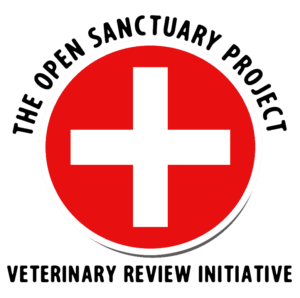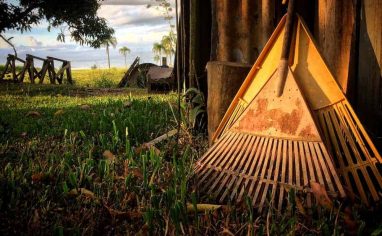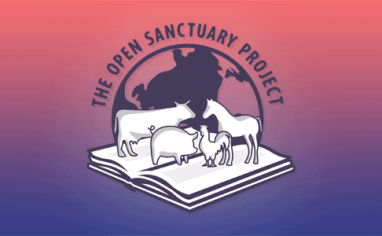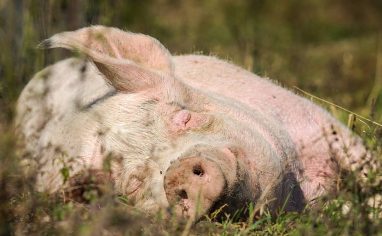
This resource was updated in preparation for veterinary review. It was originally published on March 1, 2018.

Veterinary Review Initiative
This resource has been reviewed for accuracy and clarity by a qualified Doctor of Veterinary Medicine with farmed animal sanctuaryAn animal sanctuary that primarily cares for rescued animals that were farmed by humans. experience as of February 2025.
Check out more information on our Veterinary Review Initiative here!
It’s never easy to bid a resident farewell, whether they’ve been with you for many years or just a short while. To prevent making a difficult situation needlessly more difficult, it’s important to consider ahead of time all the decisions that must be made when a resident nears the end of their life and immediately following their passing.
A Gentle Conclusion
When a resident is nearing the end of their life, our goal as caregivers should be to ensure their death is as dignified and comfortable as possible. Long before any of your residents need it, you should work to find a veterinarian who is experienced in end-of-life care for each species at your sanctuary. Each situation is different, but this may entail being able to offer guidance regarding palliative care and being comfortable performing euthanasiaThe act of ending someone’s life to spare them from suffering or a significantly reduced quality of life that cannot be managed. using gentle, non-physical methods similar to what one would expect for a beloved cat or dog companion. They can also help you work through questions regarding symptoms, when it is time to consider euthanasia, and what are the best methods for that species to have a peaceful euthanasia.
While we often wish for our residents to pass away on their own, in their sleep, without requiring euthanasia, at a certain point, their suffering may overwhelm their daily life to the point where it is no longer compassionate to continue managing their challenges if improvement to their condition is impossible. Although this may be a difficult topic for your organization to think about, you should have protocols in place regarding how euthanasia decisions are made. You can read more about this topic here.
It Shouldn’t Be About You
When a resident is nearing the end of their life, it’s important not to turn their impending death into a spectacle for humans. Although sanctuary personnel have likely built bonds and memories with them and want time to say goodbye, the resident’s psychological needs and well-being must be prioritized when determining if and how much human attention is appropriate. We recommend having ongoing discussions with sanctuary personnel about resident agency (including how to support your residents’ agency, and how to decide if and when it’s appropriate to override it), but it may be helpful to bring up the topic again and remind folks of the importance of consent-based interactions when you are preparing to say goodbye to a resident. It can also be helpful to provide some guidelines regarding what types of non-verbal cues folks should be looking for when interacting with a resident that would indicate that their presence is not appreciated, or worse, is causing distress (this is especially important if the individual is immobilized due to disease or injury). In some cases, it may be best to have an experienced caregiverSomeone who provides daily care, specifically for animal residents at an animal sanctuary, shelter, or rescue. present to oversee visits so they can gently step in if the individual is showing signs that they need a little bit of space or want to be left alone. Their end of life should be as peaceful, calm, and quiet as possible.
A Loss In The Family
If a resident passes away or is euthanized on sanctuary grounds, some sanctuaries give the individual’s non-human family and friends the opportunity to mourn with access to the resident’s body if it’s safe to do so. Each species has their own way of grieving, and letting them process their loss can make the difficult experience of death more gentle for everyone. If a resident passes away off-site, unfortunately, there is not always a practical way to give your residents this opportunity, especially with larger species such as cowsWhile "cows" can be defined to refer exclusively to female cattle, at The Open Sanctuary Project we refer to domesticated cattle of all ages and sexes as "cows." or pigs or in situations where you have decided to have a post-mortem examinationThe examination of an individual’s body after death to learn more about what led to their death, what was contributing to their clinical signs, the extent of disease, etc. performed. However, you may find that in certain circumstances it is both reasonable and beneficial to bring a resident’s body home to give their family and friends closure and time to mourn. This practice is especially helpful if one of the other residents appears to be searching or calling for their deceased companion.
Indefinite Access Is Not What We’re Talking About
While giving residents time to mourn their deceased friends can be a valuable experience, residents should NOT have indefinite access to resident remains or open burial pits due to the risk of predation, disease, and how it could emotionally impact residents and humans. To do so is unacceptable. At The Open Sanctuary Project, unacceptable means that we cannot condone (or condone through omission) a certain practice, standard, or policy. See a more detailed explanation here.
Practice Good Biosecurity
If a resident passes away suddenly or you have reason to believe they were suffering from an infectious disease, it’s important to implement biosecurity measures to protect the human and non-human animals at the sanctuary. Personnel should wear personal protective gear when handling their remains to help protect them from harmful pathogens and to reduce the risk of spread to other residents. Depending on the situation, it may not be safe or advisable to allow other residents to have access to their body, as previously described, due to the risk of disease spread. We recommend consulting with your veterinarian for specific guidance. After the individual’s body has been removed from the space, be sure to thoroughly clean and disinfect their living spaceThe indoor or outdoor area where an animal resident lives, eats, and rests. and other areas they may have had access to. Food and water dishes should also be disinfected. Bedding and old food may require special disposal to prevent disease spread – again, your veterinarian will be your best source for specific recommendations.
If Necessary, Determine Why
When a resident passes away, we are sometimes left with a number of unanswered questions. In some cases, the answers to these questions could have serious implications for your residents and require taking immediate steps to protect them. For example, an infectious disease could easily spread to other residents, or it’s possible that an environmental or nutritional contaminant could be an active danger. To learn more about what may have led to a resident’s death or caused their clinical signs, your best course of action will be to have a post-mortem examination (often called a necropsy or autopsy) conducted. While it can be difficult to think of our beloved residents being examined in this way, a post-mortem examination can be a very useful tool that comes with numerous potential benefits, which you can read more about here. In some areas, your local or regional government might perform a post-mortem examination free of charge.
Safe Remains Disposition Methods
While it’s not necessarily pleasant to think about, it’s important to consider as an organization what you will do with a resident’s remains after they have passed away (this is often referred to as ‘aftercare’). The death of a resident is often emotionally fraught, and not having a plan for the safe handling and respectful disposition of their body will add unnecessary stress to your team. We recommend looking into the options for remains disposition in your area before you require their services. This will allow you to gather the necessary information regarding logistics and cost and will give you time to have a conversation with other sanctuary personnel and your board about what feels most aligned with your sanctuary’s philosophy of care. Below, we’ll highlight the methods most commonly considered for sanctuary residents: burial, cremation, and alkaline hydrolysis. Please note that in some cases a resident’s size may limit the options available to them in your area, and available options may also be impacted by whether or not you have requested to have a post-mortem examination performed.
Burial
One option that may be available to your sanctuary is to bury residents on-site, but it’s important to look into the regulations in your area to determine if you are permitted to bury residents on sanctuary grounds. Local and regional governments all have very specific rules depending on species and zoning when it comes to burial, so it’s important to know what your legal rights and responsibilities are. If you are permitted to bury residents on-site, you must follow local regulations to ensure you do not cause environmental contamination or pose a threat to human safety or the safety of wildlife and other animals in the area. If the individual was euthanized, additional steps may be necessary to prevent environmental contamination and poisoning of wildlife or other animals. Secondary poisoning from pentobarbital, the active ingredient in many euthanasia solutions, has been reported in dogs, cats, and wildlife, so the remains of individuals who have been euthanized must be handled appropriately to prevent this from happening. The US Fish and Wildlife Service recommends that individuals euthanized with pentobarbital be cremated whenever possible (alkaline hydrolysis would also be an appropriate option to prevent secondary poisoning). If the individual is to be buried, they recommend doing so immediately and burying them deeply according to local laws and regulations.
In some cases, confirmed or suspected infectious diseases may make burial inadvisable or prohibited. If you are considering burial, we strongly recommend you first consult with your veterinarian and your local government’s environmental regulator to ensure that it will not cause harmThe infliction of mental, emotional, and/or physical pain, suffering, or loss. Harm can occur intentionally or unintentionally and directly or indirectly. Someone can intentionally cause direct harm (e.g., punitively cutting a sheep's skin while shearing them) or unintentionally cause direct harm (e.g., your hand slips while shearing a sheep, causing an accidental wound on their skin). Likewise, someone can intentionally cause indirect harm (e.g., selling socks made from a sanctuary resident's wool and encouraging folks who purchase them to buy more products made from the wool of farmed sheep) or unintentionally cause indirect harm (e.g., selling socks made from a sanctuary resident's wool, which inadvertently perpetuates the idea that it is ok to commodify sheep for their wool). and to determine a safe grave depth and location.
Burying residents on-site may give sanctuary personnel and other folks who were connected to the resident a sense of comfort knowing they are “home” and can visit them. However, keep in mind that burial locations must be chosen carefully and may not match with where you would prefer them to be if you plan to also include a memorial folks can visit. Opting for traditional cremation or alkaline hydrolysis and burying the individual’s ashes may accomplish the same goals while giving you more freedom to choose a burial location with fewer environmental concerns and safety risks.
If you determine that burial is an appropriate option, be sure to also consider logistics. Grave depth is crucial, and particularly for larger species, digging the grave may not be possible without the use of equipment such as a backhoe or excavator. Without this equipment and folks who are trained to use it, you may need to hire someone to come and dig graves for you when needed, which may or may not be feasible (especially when you consider that burial should happen soon after the individual passes away). Also, consider the regional weather and if frozen ground will make digging too difficult. When considering burial for large species, remember that equipment will be necessary to safely move the individual’s remains to the grave.
Cremation
Another option is to have the individual cremated. Some veterinary hospitals may offer cremation services at their facility, but if not, they should be able to recommend crematoriums in your area and, in the case that an individual dies or is euthanized while under their care, they may be able to arrange for transport to the crematorium. Though not widespread, some crematoriums focus on horses and other large animals and offer transportation from your property or veterinary hospital to their facility for an additional fee. When choosing to have a resident cremated, you will typically be given the option between a group cremation (sometimes called mass cremation), in which the individual is cremated with others and you do not receive their ashes back, and a private cremation (or individual cremation), in which you do. The cost of cremation services varies from facility to facility, and is typically based on weight and whether you are opting for a private or group cremation (with private cremation costing more). We recommend contacting crematoriums in your area to get an idea of the price of their services and to consider approximately how much it would cost for the different species you care for so you can determine if cremation is a viable option and can budget accordingly.
It can be comforting to have the individual’s ashes (often called cremains) returned home to the sanctuary, but it’s important to think about what you will do with their cremains. While someone who cares for a very small number of residents may opt to keep the individual’s cremains in a decorative urn or wooden box (which may be offered for an additional charge), sanctuaries with many residents (especially many larger species) may not be able to accommodate this. Instead, they may opt to do something different such as creating a memorial garden where residents’ ashes are buried. When considering what you will do with cremains, keep in mind that the quantity will be quite large for species such as cows and horses (one large animal crematorium estimates that the cremation of a horse’s body will result in about 40 pounds of cremains).
Environmental Considerations For Scattering Or Burying Cremains
If you plan on burying your resident’s cremains, perhaps along with planting a memorializing garden in their honor, it’s often recommended to mix them with an organic mixture to neutralize the naturally high pH and sodium content of the ashes. Similarly, if you are choosing to scatter their ashes, it can be a good idea to mix them with soil first. Be aware that the scattering of ashes is not permitted in certain areas, so do your due diligence before proceeding.
Traditional cremation takes a much higher environmental toll than burial or alkaline hydrolysis, with some sources suggesting that cremation (at least in human cases) creates up to five times the amount of pollutants as burial in an environmentally friendly receptacle. This is not only due to the carbon dioxide released into the atmosphere from the fire and high electricity demands, but also because cremains can have a negative impact on plants and animals when spread over the earth and into rivers and streams.
Alkaline Hydrolysis
Alkaline hydrolysis (also known as biocremation, hydrocremation, resomation, aquamation, flameless cremation, or water cremation) is an alternative to traditional cremation that produces the same dry ashes (though this process produces about 20% more ashes than traditional cremation). Rather than using incineration to break down remains, alkaline hydrolysis uses water, lye, pressure, and heat. This process has by far the lowest environmental impact of common remains disposition methods – according to Cornell University, alkaline hydrolysis uses only a tenth of the energy needed for traditional cremation. It also produces significantly less greenhouse gases. Alkaline hydrolysis is not yet as widely available as traditional cremation, but if it is available in your area, we encourage folks to choose it over traditional cremation whenever possible. Typically the cost between the two services is similar, and as with traditional cremation, you will typically be given the option between private or group alkaline hydrolysis.
Animal Services
If you cannot use any of the above methods for handling your resident’s remains, there’s a chance that the Animal Services Department of your local or regional government may provide remains disposition or be able to provide you with a list of contacts who do, but this should be considered a last resort because your resident’s body may not be handled and disposed of in a way that feels aligned with your philosophy of care. To learn more about this option, contact your government and ask whether they can provide this service or have a preferred handler.
Reflect On The Situation As A Team
After a resident passes away, regardless of the circumstances surrounding their death, your organization should strongly consider making it a policy for the sanctuary team to meet and reflect on the resident’s care, their life’s conclusion, and the aftercare that was chosen. Not only does this allow sanctuary personnel to have some time to process any emotions from the event, which is crucial for protecting against compassion fatigue, but this policy can also provide a respectful space for personnel to discuss how care decisions affected a resident’s comfort and well-being, how end-of-life and aftercare decisions affected personnel, etc. You can then discuss whether or not other options should have been considered and how that might have changed things. We recommend creating some guidelines ahead of time and discussing expectations regarding respectful communication to ensure folks have the space they need to feel safe having honest and potentially difficult discussions without placing blame on others. The goal of this reflection should be to process what happened and identify lessons that can be used to make better-informed decisions in the future. Personnel who raise concerns about decisions that were made should be heard and the group should talk through why the decision was made and whether or not it would be made again in a similar situation.
Folks who might not have been as involved with a resident’s care or who are newer to the animal caregiving field should be given ample space to ask questions to help better understand the reasons behind why certain care decisions were made, alleviating any potential misunderstandings or confusion in a nonjudgmental way.
With this space for perspective, your organization can hopefully pinpoint areas where care for a resident excelled and where things could be done differently. From here, you can update your care policies and procedures, if necessary, for future scenarios that your organization might experience.
Tell Their Story
It’s important to consider finding a way to honor your departed residents, and we recommend discussing as a team what feels appropriate. This might include posting a tribute to the individual in your newsletter and/or on social media, holding a private or public ceremony or event and allowing folks to pay their respects, or honoring the individual in a memorial garden. Providing an opportunity for folks to share stories and positive memories of the individual and how they were impacted by them can be a great way for folks to mourn while also celebrating the individual’s life. Your residents make your sanctuary special, and they deserve to have their memories cherished by those who cared for and loved them.
Keeping Record Of End-Of-Life Events
In order to help sanctuaries track End-Of-Life care at their organizations, we’ve developed a free downloadable form just for this purpose. We encourage all sanctuaries to either use our free form or develop one that suits their specific needs!
SOURCES:
How To Bury A Pet: End-of-Life Options For Our Beloved Companions | One Health Organization
Equine And Large Animal Cremation Services | Dignified Pet Services
Pet Aquamation Vs Flame-based Cremation: Which Is The Better Option? | Compassionate Care
HydroCremation | Cornell University College Of Veterinary Medicine
Planting In Cremation Ashes – Are Cremation Ashes Good For Plants | Gardening Know How
AVMA Guidelines For The Euthanasia Of Animals: 2020 Edition | American Veterinary Medical Association (Non-Compassionate Source)
Non-Compassionate Source?
If a source includes the (Non-Compassionate Source) tag, it means that we do not endorse that particular source’s views about animals, even if some of their insights are valuable from a care perspective. See a more detailed explanation here.








